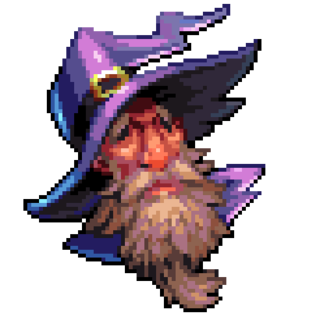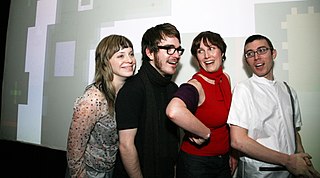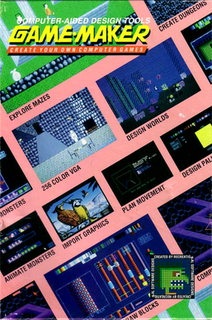
A player character is a fictional character in a video game or tabletop role-playing game whose actions are controlled by a player rather than the rules of the game. The characters that are not controlled by a player are called non-player characters (NPCs). The actions of non-player characters are typically handled by the game itself in video games, or according to rules followed by a gamemaster refereeing tabletop role-playing games. The player character functions as a fictional, alternate body for the player controlling the character.

The Avatar is the main player character and protagonist in the Ultima series of video games by Origin Systems. The character was first introduced as "The Stranger" in the 1981 role-playing video game Ultima I: The First Age of Darkness.

Pixel art, also called Pixel-art or simply Pixelart, refers to a form of digital art, drawn with software, whereby images are built with the exclusive and intentional placement of pixels.

The Monochrome Display Adapter is IBM's standard video display card and computer display standard for the PC introduced in 1981. The MDA does not have any pixel-addressable graphics modes, only a single monochrome text mode which can display 80 columns by 25 lines of high resolution text characters or symbols useful for drawing forms.

The X68000 is a home computer created by Sharp Corporation. It was first released in 1987 and sold only in Japan. Gaming was a major use of the X68000, with custom sprite hardware and an 8-channel sound chip enabling ports of contemporaneous arcade video games.

In computing, an avatar is a graphical representation of a user or the user's character or persona. It may take either a two-dimensional form as an icon in Internet forums and other online communities or a three-dimensional form, as in games or virtual worlds. Avatar images have also been referred to as "picons" in the past, though the usage of this term is uncommon now. An avatar can also refer to a text construct found on early systems such as MUDs. The term "avatar" can also refer to the personality connected with the screen name, or handle, of an Internet user.

3D Monster Maze is a survival horror computer game developed from an idea by J.K. Greye and programmed by Malcolm Evans and released in February 1982 for the Sinclair ZX81 platform with the 16 KB memory expansion. The game was initially released by J. K. Greye Software in early 1982 and re-released later the same year by Evans' own startup, New Generation Software. Rendered using low-resolution character block "graphics", it was one of the first 3D games for a home computer, and one of the first games incorporating typical elements of the genre that would later be termed survival horror.

Jason Rohrer is an American computer programmer, writer, musician, and game designer. He publishes most of his software into the public domain and charges for commercial platform distributed versions of his games, like on the iPhone appstore or Steam. He is a graduate of Cornell University. From 2004 until 2011 he practiced simple living, stating in 2009 that his family of four had an annual budget of less than $14,500. They have since relocated from Las Cruces, New Mexico to Davis, California. In 2005 Jason Rohrer worked on a local currency, called North Country Notes (NCN), for Potsdam, New York. In 2016 Rohrer became the first videogame artist to have a solo retrospective in an art museum. His exhibition, The Game Worlds of Jason Rohrer, was on view at The Davis Museum at Wellesley College until June 2016.

Doomguy, also referred to as the Doom Marine, the Doom Slayer or just the Slayer, is a fictional character from the Doom video game franchise of first-person shooters created by id Software. He was created by American video game designer John Romero. He was introduced as the player character in the original 1993 video game Doom. Within the Doom series, Doomguy is a space marine dressed in green combat armor who rarely speaks onscreen, and his personality and backstory was intentionally vague to reinforce his role as a player avatar. In Doom Eternal, he is voiced by American voice actor Matthew Waterson, while Jason Kelley voices the character in that game's downloadable content The Ancient Gods: Part Two. He has appeared in several other games developed by id Software, including Quake Champions and Quake III Arena.

A Mii is a customizable avatar used on several Nintendo video game consoles and mobile apps. Miis were first introduced on the Wii console in 2006 and later appeared on the 3DS, Wii U, the Switch, and various apps for smart devices. Miis can be created using different body, facial and clothing features, and can then be used as characters within games on the consoles, either as an avatar of a specific player or in some games portrayed as characters with their own personalities. Miis can be shared and transferred between consoles, either manually or automatically with other users over the internet and local wireless communications.

Kokoromi is a group with the intent of promoting video games as an art form, and experimental gameplay worldwide. The collective consists of game pioneers and curators Damien Di Fede, Phil Fish, Heather Kelley, and Cindy Poremba. Most of the members met in 2005, working on a small game project for a cultural event in Montreal.

First-person shooter (FPS) is a sub-genre of shooter video games centered on gun and other weapon-based combat in a first-person perspective, with the player experiencing the action through the eyes of the protagonist and controlling the player character in a three-dimensional space. The genre shares common traits with other shooter games, and in turn falls under the action game genre. Since the genre's inception, advanced 3D and pseudo-3D graphics have challenged hardware development, and multiplayer gaming has been integral.
In video games, a silent protagonist is a player character who lacks any dialogue for the entire duration of a game, with the possible exception of occasional interjections or short phrases. In some games, especially visual novels, this may extend to protagonists who have dialogue, but no voice acting like all other non-player characters. A silent protagonist may be employed to lend a sense of mystery or uncertainty of identity to the gameplay, or to help the player identify better with them. Silent protagonists may also be anonymous. Not all silent protagonists are necessarily mute or do not speak to other characters; they may simply not produce any dialogue audible to the player.

Game-Maker is an MS-DOS-based suite of game design tools, accompanied by demonstration games, produced between 1991 and 1995 by the Amherst, New Hampshire based Recreational Software Designs and sold through direct mail in the US by KD Software. Game-Maker also was sold under various names by licensed distributors in the UK, Korea, and other territories including Captain GameMaker and Create Your Own Games With GameMaker!. Game-Maker is notable as one of the first complete game design packages for DOS-based PCs, for its fully mouse-driven graphical interface, and for its early support for VGA graphics, Sound Blaster sound, and full-screen four-way scrolling.

Philippe Poisson, better known as Phil Fish, is a French Canadian former indie game designer best known for his work on the 2012 platform game Fez. He was born and raised in Quebec, where his experiences with Nintendo games in his youth would later influence his game design. He studied game design at the Montreal National Animation and Design Centre, and worked at Ubisoft and Artificial Mind and Movement before starting Polytron in 2008.

Diamond Trust of London is a turn-based strategy video game by Jason Rohrer, with music by Tom Bailey. Following a crowdfunding campaign on Kickstarter the game was published by indiePub and released for the Nintendo DS on August 28, 2012. The game has been placed in the public domain and is hosted on SourceForge.

The Castle Doctrine is a 2014 strategy video game developed and published by Jason Rohrer for Microsoft Windows, OS X, and Linux via Valve's Steam platform. The game was released on January 29, 2014 for all platforms and is available as public domain software on SourceForge. Set in the early 1990s, it pits players against one another as they invade others' houses and attempt to steal money from their vaults, while also setting up traps and other obstacles to keep their own vaults safe.

One Hour One Life is a 2018 survival massively multiplayer online game developed and published by Jason Rohrer. Each player lives for, at most, 60 minutes in a large, persistent world, with each minute representing a year of life. They must gather and grow food, craft tools and build societies in order to survive. The game's source code and assets are placed into the public domain, and are freely available on GitHub, with accounts being sold for access to the primary servers hosting the game. Originally available only on the website onehouronelife.com, it was later released on Steam in November 2018.













